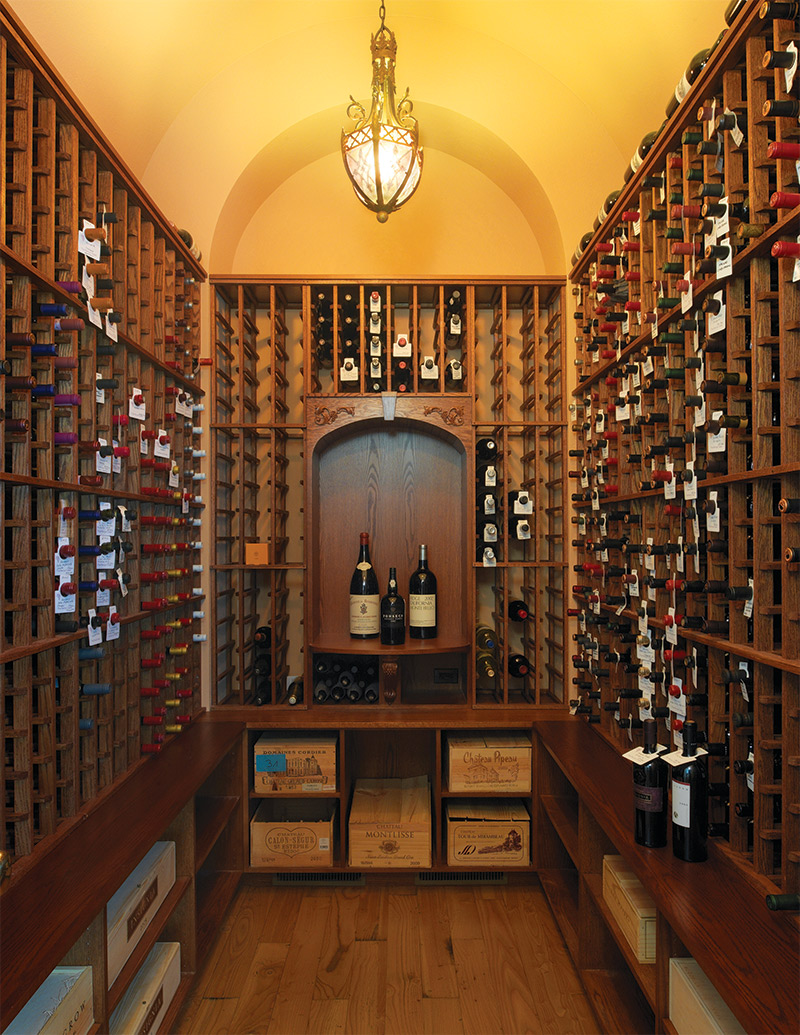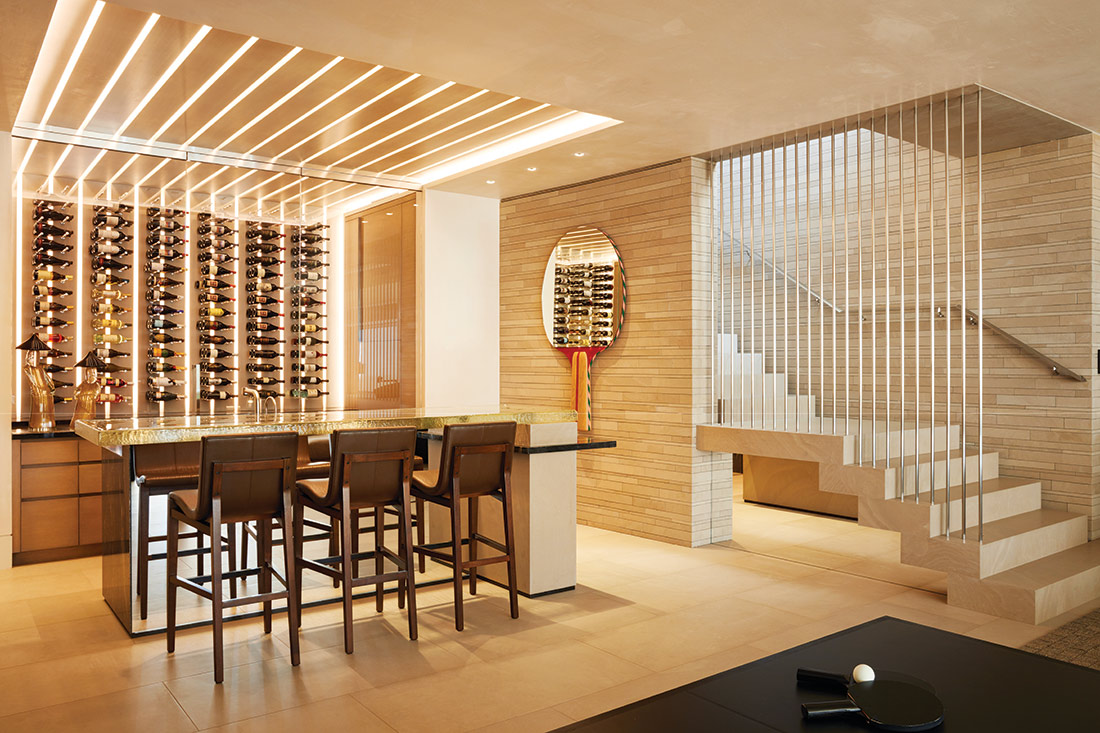Wine is a living entity that changes with time in the bottle, so properly storing your investment assures you can savor it in mint condition. What makes the ideal home wine cellar? As you can see from the examples shown, it depends upon your space availability, desired function for the cellar, and design style. You also need to consider some basics.
“First, plan on more storage than you need,” says Brahm Callahan, master sommelier and beverage director for Himmel Hospitality Group in Boston. “A 400-bottle collection will fill your cellar quickly, particularly if you’re a collector. While it’s nice to display bottles, wine is most valuable (for insurance purposes or selling) in its original packaging, like the wooden cases, which are a nice aesthetic in themselves.”
Next, the cellar must be vibration free from equipment like a dishwasher above the cellar. Vibrations disturb the bottle’s sediment and increase unwanted chemical reactions in the wine. Bottles should lie flat enough to keep corks moist in a temperature- and humidity-controlled environment. “I recommend a constant temperature of 50 degrees,” says Callahan, with relative humidity no less than 70 percent.
At Casa Ambar in Cabo San Lucas, Mexico, the homeowners wanted a wine cellar as green as their three-story residence built into a mountainside.
“The entry and garage are on the top level, the living area in the middle, and the bedrooms on the bottom, so we put the wine cellar on the middle floor buried into the ground on two sides, so it was basically in the back of the house,” says Mark Simon, principal of Centerbrook Architects & Planners in Centerbrook, Connecticut.
The 100-square-foot space has masonry white walls, stone tile flooring, and a refrigeration and condensing unit to control the temperature and humidity of up to 3,000 bottles. A black quartz-topped sink makes for easy cleanup, while a floating double-drawer cabinet holds logs for tasting notes. A wooden door softens the space, along with a wooden counter, wooden wall wine racks, a wooden tasting table, and tree trunk-topped stools.


“In a house that has a lot of hard white surfaces and is filled with day light, this wine cellar is like a nice little cave,” says Simon.
When the owners of Boothden in Middleton, Rhode Island hired David S. R. Andreozzi NC, ARB, AIA of Andreozzi Architecture in Barrington, Rhode Island, to restore their 1883 estate (originally built for actor Edwin Booth, brother of John Wilkes Booth), they also requested a wine cellar.
“A lot of tasting areas are inside wine cellars, but the reality is, it’s cold in there!” says Andreozzi. “So, I suggested the wine cellar have an interior storage area and exterior sitting area with a flat screen TV, sound system, and area for smoking cigars.”
The resulting 140-square-foot cellar holds 600 bottles, 400 of which can rest in mahogany racks built by the husband, who also crafted matching mahogany veneer plywood base cabinets. A refrigeration and condensing unit controls humidity and temperature and plaster walls and stone tile flooring provide a finished look to both the cellar and tasting area, separated by an arched wooden door with a stained-glass sun, symbolizing the rebirth of Boothden (via the restoration) and the sun’s importance for growing wine grapes.
“The cellar has become the couple’s inner sanctum, where enjoying their wine feels almost like a religious experience,” says Andreozzi.
To match the ultra-hip design of Ridge House in Los Angeles, California, the homeowners asked Los Angeles-based Richard Landry, AIA, president of Landry Design Group, to create an equally cutting-edge wine cellar.
“They wanted it to be part of a larger space that functions as a rec room, TV lounge, and bar,” says Landry, who fashioned an 875-square-foot lounge and bar facing a glass fronted, 100 square-foot wine cellar, reached by a frameless glass door. “We’ve been doing lots of frameless glass wine cellars because they’re modern but also make the cellar disappear,” says Landry.
A refrigeration and condensing system controls temperature and humidity, while stone flooring connects the two spaces, along with a grooved, wood plank ceiling with linear LED lights that illuminate the wines, showcased horizontally on a 270-bottle wall rack with drawers and side cabinets underneath to hold serving pieces.
“Displaying the wine sideways, versus just seeing the end of the bottle, is a trend,” says Landry. “It provides easy access to the wine, while making an aesthetic statement about the space.”
5 Great California Wines for Cellaring
Below are some of Callahan’s favorite California wines from iconic producers who helped develop the state’s fine wine industry.
Diamond Creek
This Napa Valley producer crafts elegant, firm wines and single vineyard Cabernets, like Diamond Creek Gravelly Meadow Cabernet Sauvignon.
Ridge Vineyards
Famed for their Montebello Cabernet, this producer also makes collection-worthy single vineyard Zinfandels, like the spicy Ridge Zinfandel Geyserville, drinkable young, but ages well.
Larkmead Vineyards
Winemaker Dan Petroski creates polished, beautifully integrated wines at this 1895 winery, including Larkmead Vineyard Cabernet Sauvignon Solari, perfect for aging given its firm tannins and strong oak profile.
Hanzell
This Sonoma producer makes incredibly long-lived Pinot Noir and Chardonnays, such as Hanzell Sebella Chardonnay, approachable when young, but exquisitely complex when aged.
Mayacamas
While this 1889 Napa Valley pioneer is known for its Cabernet, it makes a stellar Mayacamas Merlot Napa from Mount Veeder grown grapes, giving it more structure than some valley floor wines.
For more information, visit himmelhospitality.com, landrydesign.net, centerbrook.com, andreozzi.com


